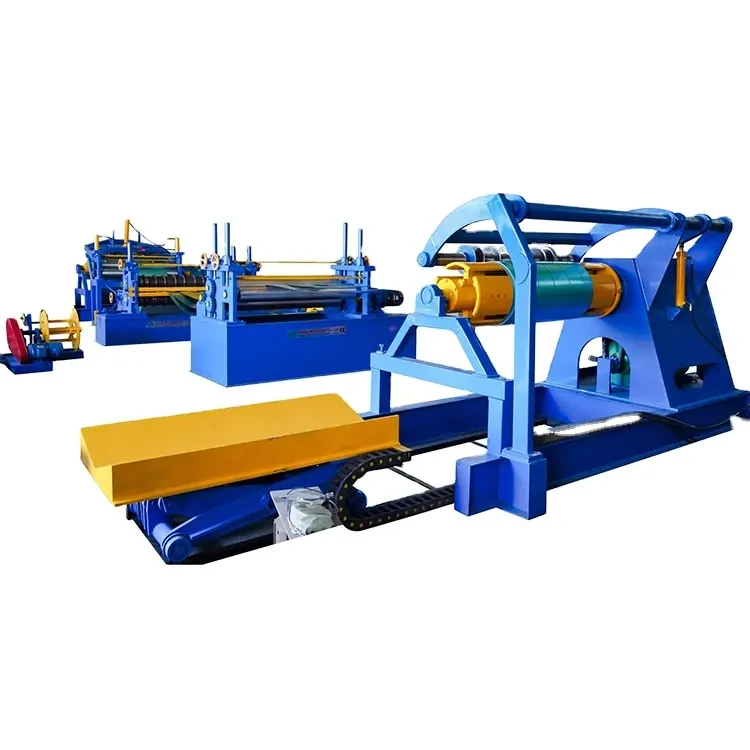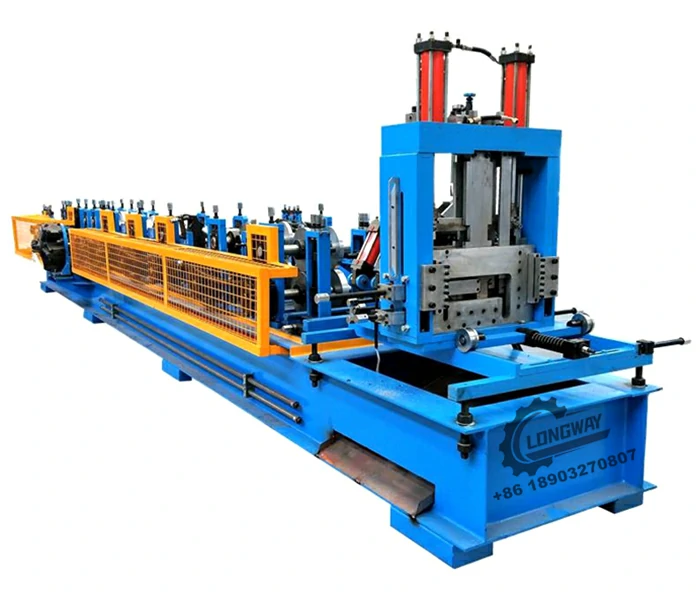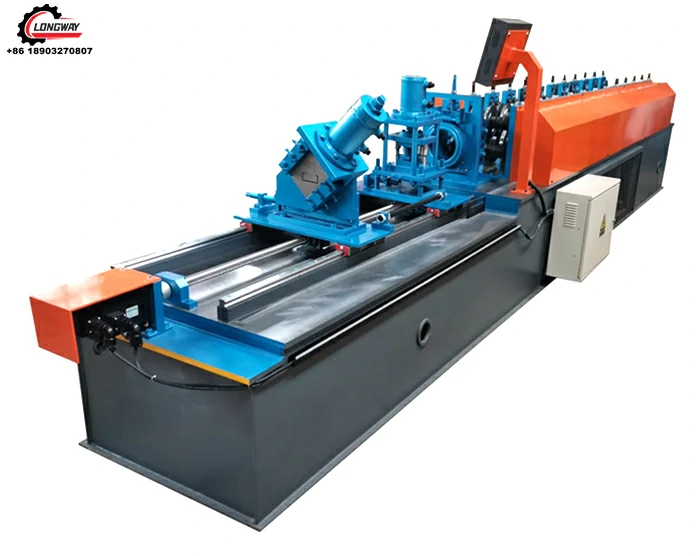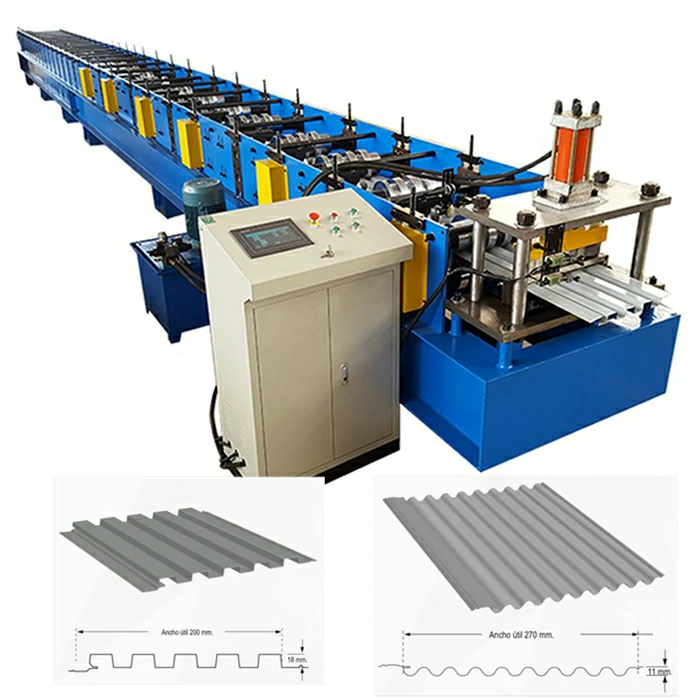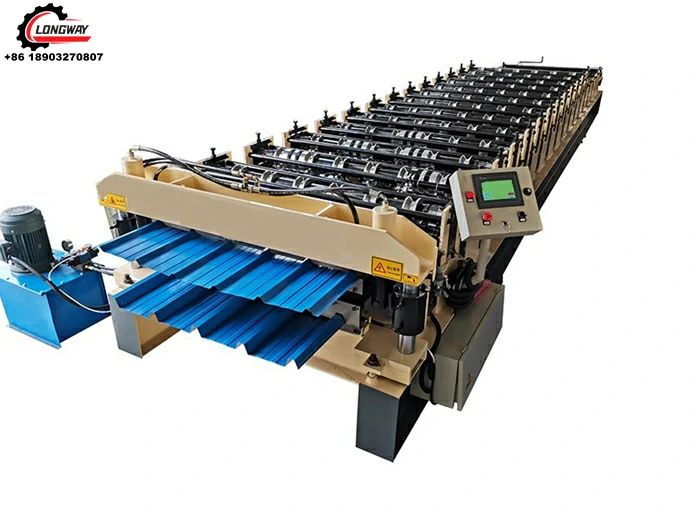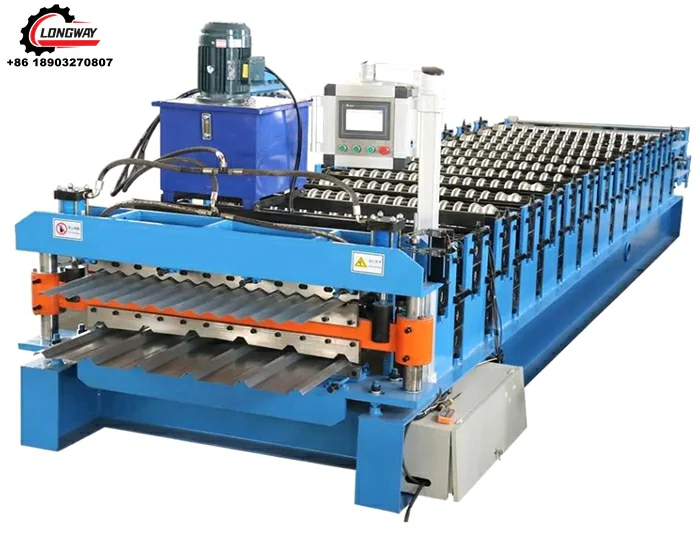metal roofing machine-Rollforming Rolls Forward
Rollforming Rolls Forward
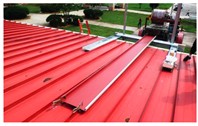
Rollforming equipment is an effective and efficient way to build metal roofs
In recent years, metal roofing suppliers and rollformer manufacturers have seen an increase in rollforming demand. It continues to gain market share on its rival products such as asphalt and membrane roof systems. Advancing technologies in paint and steel have allowed metal roofing manufacturers to provide longer and better warranties for growing industries.
Rollforming feeds a continuous sheet of steel material via a die-coiler through a series of rollers and rollforming dies that bend the material slightly at each pass to form a particular metal roof panel profile.
“The rollformer is equipped with a multi-batch controller which allows a machine operator to program the quantity and length of each batch to be run,” says Dan McDonald, president of Metal Rollforming Systems, Spokane, Wash. “The rollformer then cuts the sheet to the appropriate length and continues to run through progressive bend tooling to form the shape of the panel. The completed panel is then discharged from the rollformer and is ready for packing and installation.”
Rollformers come in portable and in-factory machines. Portable machines are smaller and typically lighter duty for transportation reasons. They are dedicated to a specific profile and typically operate at a slower production speed. Portable rollformers can run long-length panels on job sites that typically would be difficult or impossible to ship to via truck. McDonald says these panels are generally standing-seam or snap-lock style roof panels that do not nest easily on top of each other.
In-factory rollforming machines are larger and designed for large production volumes. They can be configured to produce multiple profiles on the same rollformer and can incorporate handling and packaging equipment. They produce panels with features like end swaging, hole punching and lap notching, and form wider multi-rib panels.
The move to portable
Portable rollforming machine usage and end-product quality have grown in recent years. “Portable technology has improved over the last five years, so it is virtually impossible to see the difference between a product produced via a fixed-in-place rollformer or a portable,” says Brian Partyka, president of Drexel Metals Inc., Philadelphia.
 With rollforming, generally the more roll stations used, the higher the quality. More stations allow the process to form the material more gradually and produce much more consistent forming. “That is the argument the in-plant guys have been making all these years,” says Geoff Stone, owner of Metalforming Inc., Peachtree City, Ga. “They will say portable machines ‘don’t sufficiently form’ and so on. But with modern technology and design, most portable machines can at least make most of the profiles. There are some profiles that can’t be produced on the small machines because they literally can’t be produced in that small space with too few rolls. The in-plant manufacturer has profiles typically too complex to be formed on a 10-station machine, which would be the average number of rolls in a portable machine. Sometimes desired profiles require a larger portable machine that we do make, like a 14-roll station machine. However, once you get over 14 roll stations, the machines just get too big to carry around.”
With rollforming, generally the more roll stations used, the higher the quality. More stations allow the process to form the material more gradually and produce much more consistent forming. “That is the argument the in-plant guys have been making all these years,” says Geoff Stone, owner of Metalforming Inc., Peachtree City, Ga. “They will say portable machines ‘don’t sufficiently form’ and so on. But with modern technology and design, most portable machines can at least make most of the profiles. There are some profiles that can’t be produced on the small machines because they literally can’t be produced in that small space with too few rolls. The in-plant manufacturer has profiles typically too complex to be formed on a 10-station machine, which would be the average number of rolls in a portable machine. Sometimes desired profiles require a larger portable machine that we do make, like a 14-roll station machine. However, once you get over 14 roll stations, the machines just get too big to carry around.”
While higher speeds and slightly better quality come from in-plant machines, portable machine quality is more than sufficient for metal roof applications. “In-plant machines can run 200 feet per minute, but portable machines will typically run at 60 to 80 feet per minute,” Stone says. “But the slower speed of the portable doesn’t impact anything because the machines can make panels faster than they can be installed.”
Architects are responsible for a structure’s on-time completion, its integrity and any lastminute deviations in documents and schedule. “One of the easiest ways to avoid issues with a metal roof is to choose a product and a contractor where the roofing material can be rollformed and installed on the job site,” says Tom Dyszkiewicz, senior vice president at Englert Inc., Perth Amboy, N.J. “Other methods can lead to delays in schedule and design concerns. Fabrication of long sheet lengths on-site at the ground, eaves or roof level dramatically speeds installation and overcomes problems of delivery and access. On-site capability also means that spans of more than 120 meters or more can be achieved with no end laps.”
Double layer roofing sheet roll forming machine
With on-site rollforming, if a panel is damaged or cut short, another can be run immediately. There is no waiting for replacement panels.

Worksite conditions are another reason architects are specifying rollformers to install metal roofing. Usually, several contractors and subcontractors with vehicles, labor and building materials are all working simultaneously on a single job site. Often, there is little or no room for equipment and materials to be stored before and during a job. Factory-supplied materials must be stored and carted from the storage site over to the building, requiring several workers to carry out the material and several others to set it up on the roof. Factory manufactured panels have to be lifted to the roof. Four to eight men on the roof, and four to eight on the ground would be required to handle a panel, some of which can be more than 150 feet long.
“Portable rollforming virtually eliminates the possibility of factory error in measuring and cutting panel materials that could tie up a job for weeks,” says Dyszkiewicz. “On-site rollforming also eliminates storage requirements including forklifts and heavy equipment necessary to unload and store factory supplied materials. It eliminates concerns about bad weather affecting storage and mobility onsite.
“With a rollformer you can position the machine where the work needs to be done and run the panels to the lengths the job requires. On high-rise structures you can ‘crane’ the rollforming machine in the air, abut the machine to the side of a rooftop and shoot panels onto the roof-a major savings in time and labor. Panels can be radiused right on the roof and curved with the use of a curving machine.”
Transport, scrap and cost
Shipping coil is less expensive than shipping panels. Also, on-site rollforming reduces lead time, packaging, freight, and waste like skids, crates and dumpster fees. “We can ship 26,000 lineal feet of 24-guage coil versus 12,000 lineal feet of finished panels, making on-site manufacturing more ecoefficient,” Partyka says. “This is equal to 32,500 square feet of 16-inch panels versus 15,000 square feet of 16-inch panels from in-factory producers. That’s twice the freight savings.”
When most contractors order panels from an in-plant factory, they typically order 10 percent more than they need because of what happens in the shipping, transport and ground staging.
“They build that into the price, where the portable machine companies don’t do that,” Stone says. “You don’t need staging areas or scrap containers. You don’t need to get rid of all of the packaging and there is a massive amount of packaging with the in-plant panels. You don’t have transport costs which are very significant and are getting worse every day. How do all the packaging, scrap and transportation costs fit into the green roofing concept? Architects are choosing metal because of its green aspect. Architects are looking for LEED points for the environmental nature of their building. For example, when they are doing government work they have to have so many points. This can come in a reduction of trash.”

While it is true users save money on packaging and reduce the possibility of freight damage by having a portable rollformer, the risk of damage to the machine increases when it travels. McDonald warns that moisture that exterior elements like moisture and extreme heat, along with road elements can harm the rollformer.
Buying and leasing
Metal rollforming can be leased or financed either through local banks or third-party finance companies. “The cost benefit of leasing or financing is that you will receive the same benefits in regards to Section 179 write-off and bonus depreciation as you would if you paid cash,” says Jim Denning, vice president of manufacturing equipment distribution at TCF Equipment Finance Inc., Nashville, Tenn. “In addition, the use of the asset makes you money, not the ownership of said asset. So basically what you are doing is paying for the equipment as you use it, and it makes the payments for you over time versus laying out the cash for the machine now and having the machine repay you over time.”
Many contractors are reluctant to buy a $60,000 piece of equipment, and leasing offers greater flexibility. “Many will lease over the span of 60 months, which is the average time frame,” Stone says. “The leasing companies are charging interest, so you would likely be paying
$1,200/ month for this $60,000 machine over 60 months. Leasing lets you retain your capital and it lets you use the technology to earn money immediately at a relatively low cost.”
Another important leasing advantage, which will end at the end of 2011, is the stimulus program allowing contractors to write off the entire cost of a machine in the year that it is bought. “The contractor can depreciate it all at once,” Stone says. “If a contractor is in the 35 percent tax bracket and he buys a $60,000 machine, he can end up with a $21,000 tax deduction. This means his actual cost of buying the machine after the tax implication is only $39,000. If he leases it, and he gets all the depreciation in year one, and it cost him $1,200/ month, he’s going to get a $21,000 tax benefit. This means the government is paying for it for 17 1/2 months of his lease cost.”
In spite of its benefits, leasing has become more restricted in recent years, mostly due to the recession. “Leasing was the easiest thing in the world, now it’s very difficult because leasing companies lost so much money from nonpayment and defaults in the recession,” Stone says. “We have good customers who have leased for years from leasing companies and made every payment on time and now the leasing companies won’t give them another lease now, because they are in the construction business and the construction business is deadly as far as risk managers are concerned. The loss of credibility in the industry has been very difficult for us.”
When assessing the many metal rollforming options and costs available, quality must remain a determining factor. “The focus needs to be on the end-product quality produced from any given rollformer,” says Brett Barber, sales team leader at Bradbury Rollforming Equipment, Moundridge, Kan. “Don’t take for granted that all are created equal in terms of build, operations features and end-panel quality.”
-
Roof Panel Machines: Buying Guide, Types, and PricingNewsJul.04, 2025
-
Purlin Machines: Types, Features, and Pricing GuideNewsJul.04, 2025
-
Metal Embossing Machines: Types, Applications, and Buying GuideNewsJul.04, 2025
-
Gutter Machines: Features, Types, and Cost BreakdownNewsJul.04, 2025
-
Cut to Length Line: Overview, Equipment, and Buying GuideNewsJul.04, 2025
-
Auto Stacker: Features, Applications, and Cost BreakdownNewsJul.04, 2025
-
Top Drywall Profile Machine Models for SaleNewsJun.05, 2025


